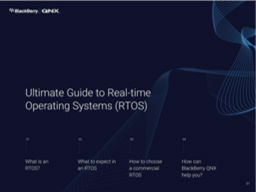Ultimate Guide to Real-time Operating Systems (RTOS)
A real-time operating system (RTOS) must be fast and responsive, schedule tasks and manage limited resources, and ensure functions are isolated and free of interference from other functions.
In this report, you'll learn more about what is a real-time OS and the pros and cons of two types of RTOS architectures: monolithic and microkernel.
Read More
By submitting this form you agree to BlackBerry QNX contacting you with marketing-related emails or by telephone. You may unsubscribe at any time. BlackBerry QNX web sites and communications are subject to their Privacy Notice.
By requesting this resource you agree to our terms of use. All data is protected by our Privacy Notice. If you have any further questions please email dataprotection@techpublishhub.com
Related Categories: Cellular, Communication, Development and debug tools, Edge computing, Embedded, Embedded operating systems and software, Evaluation boards, LPWAN technologies, Microcontrollers, Near-Field Communication (NFC), SBCs and modules, Sub-GHz/ISM-band radio, Wireless networking ICs and modules


More resources from BlackBerry QNX

The Past, Present and Future of Cybersecurity for Embedded Systems
The only system that's safe from cyberthreats is one that's never powered on. While this is an overstatement meant to highlight the seriousness of ...

Accelerate Innovation: How Adopting a Scalable Platform Architecture can Speed Product Development
The pace of innovation has changed. Original equipment manufacturers (OEMs) can no longer take years to introduce new products or update functional...

Ultimate Guide to Functional Safety and Safety Certification
Functional safety actively prevents the failure of a system from causing harm to people and property. Developers often need to certify a system as ...
